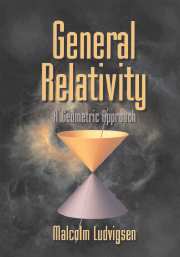2 - Events and Spacetime
Published online by Cambridge University Press: 04 June 2010
Summary
Events
Lightning striking a tree, a brief encounter between friends, the battle of Hastings, a supernova explosion, a birthday party – these are all examples of events. An event is simply an occurrence at some specific time and at some specific place. Events, as we shall see, form the basic elements of the spacetime description of the universe.
The world line of a particle is the sequence of events that it occupies during its lifetime. Birthday parties, for example, form a particularly important set of events on any person's world line. A brief encounter between two friends is an event common to both their world lines (Fig. 2.1).
Most real events are very fuzzy affairs with no definite beginning or end. A pointlike event, on the other hand, is one that appears to occur instantaneously to any observer capable of seeing it.† A collision between two pointlike particle, for example, is a pointlike event. It is, of course, possible to have a nonpointlike event that appears to be instantaneous to some observer, but, due to the finite velocity of the propagation of light, such an event will not in general appear to be instantaneous to some other observer. We say that two pointlike events occupy the same spacetime point if they appear to occur simultaneously to any observer capable of seeing them. If this is not the case, we say that they occupy distinct spacetime points. It is, of course, possible to have two events occupying distinct spacetime points that appear simultaneously to some observer, but, again because of the finite velocity of the propagation of light, they will not, in general, appear simultaneous to some other observer.
- Type
- Chapter
- Information
- General RelativityA Geometric Approach, pp. 12 - 18Publisher: Cambridge University PressPrint publication year: 1999

